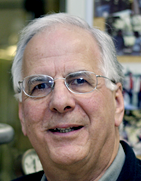Brian Sykes

Distinguished University Professor
Ph.D, Stanford University
Lab: 780-492-3006
brian.sykes@ualberta.ca
Research:
Our research involves the elucidation of the structure, dynamics and function of proteins; including the role of intrinsically unfolded regions in regulating biological interactions. The major systems focus of our research is cardiovascular disease. In particular, we are interested in the function of the proteins that make up the thin filament of skeletal and cardiac muscle and regulate contraction; focusing on the calcium sensitive interactions between actin, tropomyosin, and troponin. We are presently studying the effects of drug binding, phosphorylation, acidosis and FHC mutations in the cardiac system. Our major tool is nuclear magnetic resonance spectroscopy, especially the use of multi-nuclear and multi-dimensional NMR techniques combined with the computational techniques of energy minimization and molecular dynamics to determine the structure of proteins in solution. We are also studying prion proteins in order to understand the mechanism of the conversion from the cellular to the Scrapie form; using NMR based metabolomic studies to diagnose human disease; and developing NMR methods for the study of the structure of membrane proteins.Selected Publications:
Conversion of a Cardiac Muscle Modulator from an Inhibitor to an Activator
Cai F, Kampourakis K, Parijat P, Cockburn KT, Sykes BD.
J Med Chem Lett (2023) 14, 530-533
Drugging the Sarcomere, a Delicate balance: Position of N-Terminal Charge of the Inhibitor W7
Cai F, Kampourakis K, Cockburn KT, Sykes BD.
ACS Chemical Biology (2022) 17, 1495-1504
A Potent Fluorescent Reversible-Covalent Inhibitor of Cardiac Muscle Contraction
Cai F, Kampourakis K, Klein BA, Sykes BD.
J Med Chem Lett (2021) 12, 1503-1507
Structural basis of tirasemtiv activation of fast skeletal muscle troponin
Li MX, Mercier P, Hartman JL, Sykes BD.
J. Med. Chem (2021) 64, 3062-3064.
The Role of Electrostatics in the Mechanism of Cardiac Thin Filament Based Sensitizers
Cai F, Robertson IM, Kampourakis T, Klein BA, Sykes BD.
ACS Chemical Biology (2020) 15, 2289-229.
Structural and functional consequences of the cardiac troponin C L48Q Ca2+-sensitizing mutation.
Wang D, Robertson I.M, Li MX, McCully M, Crane ML, Luo Z, Tu A., Daggett V, Sykes BD, Regnier M.
Biochemistry. (2012) Jun 5;51(22):4473-87.
Interaction between the regulatory domain of cardiac troponin C and the acidosis resistant cardiac troponin I A162
Pineda-Sanabria S, Robertson IM, Li MX, Sykes, BD
Cardiovascular Research (2013) 97(3); 481-489.
Structural and Functional Insights into the Cardiac Na+/H+ Exchanger.
Lee BL, Sykes BD, Fliegel L.
Journal of Molecular and Cellular Cardiology (2013) 61(08): 60-76.
Conformation of the critical pH sensitive region of troponin depends upon a single residue in troponin I.
Robertson IM, Pineda-Sanabria SE, Holmes PC, Sykes BD.
Archives of Biochemistry and Biophysics (2014) 552-553:40-49.
The intrinsically disordered cardiac-specific N-terminal region of troponin I positions the regulatory domain of troponin C.
Hwang PM, Cai F, Pineda-Sanabria SE, Corson DC, Sykes BD,
Proc Natl Acad USA (2014) 111(40), 14412-14417.
Computer-aided drug discovery approach finds calcium sensitizer of the cardiac troponin complex.
Lindert S, Li MX, Sykes BD, McCammon JA.
Chemical Biology & Drug Design (2015) 85(2), 99-106.
Targeting the sarcomere to correct muscle function.
Hwang PH, Sykes BD.
Nat Rev Drug Discovery (2015) 14, 313-328.
Lab Members
Links
Location
Office: 419B MSB
Lab: 419 MSB